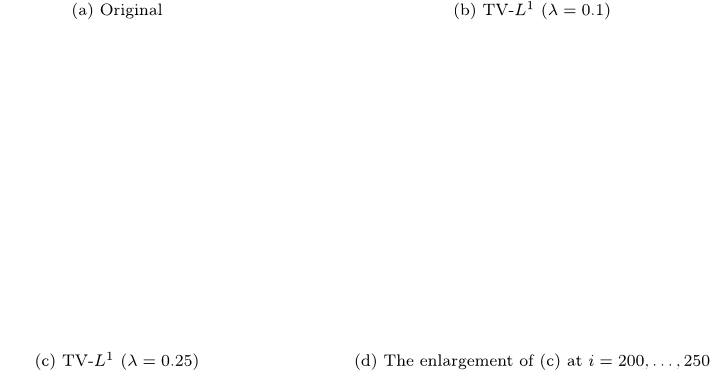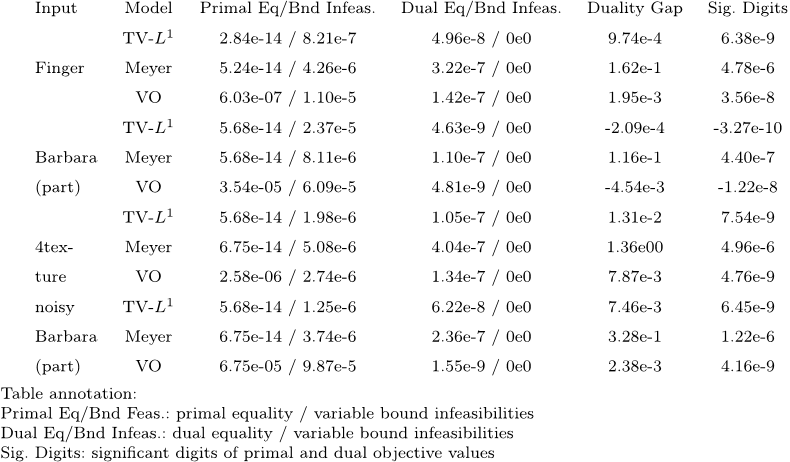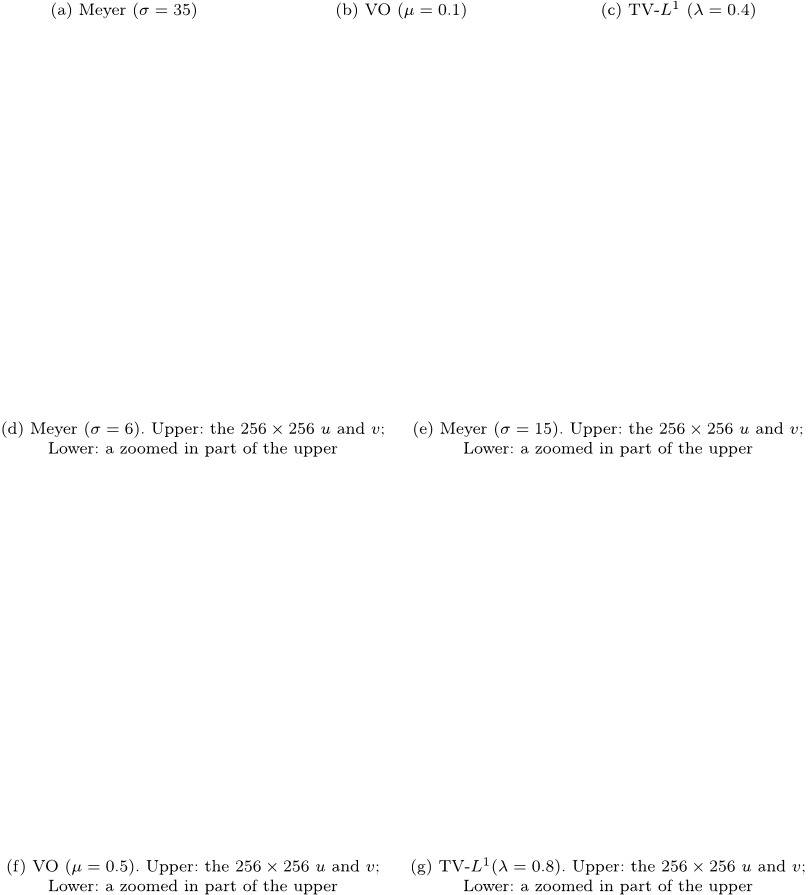A comparison of three total variation based texture extraction models
Summary (2 min read)
1 Introduction
- Let f be an observed image that contains texture and/or noise.
- Texture is characterized as repeated and meaningful structure of small patterns.
- Noise is characterized as uncorrelated random patterns.
- The rest of an image, which is called cartoon, contains object hues and sharp edges .
1.1 The spaces BV and G
- In image processing, the space BV and the total variation semi-norm were first used by Rudin, Osher, and Fatemi [33] to remove noise from images.
- The ROF model is the precursor to a large number of image processing models having a similar form.
1.3 Second-order cone programming
- Since a one-dimensional second-order cone corresponds to a semi-infinite ray, SOCPs can accommodate nonnegative variables.
- In fact if all cones are onedimensional, then the above SOCP is just a standard form linear program.
- As is the case for linear programs, SOCPs can be solved in polynomial time by interior point methods.
- This is the approach that the authors take to solve the TV-based cartoon-texture decomposition models in this paper.
2.2.3 The Vese-Osher (VO) model
- This is equivalent to solving the residual-free version (45) below.
- The authors chose to solve the latter in their numerical tests because using a large λ in (44) makes it difficult to numerically solve its SOCP accurately.
3 Numerical results
- Similar artifacts can also be found in the results Figures 2 (h )-(j) of the VO model, but the differences are that the VO model generated u's that have a block-like structure and thus v's with more complicated patterns.
- In Figure 2 (h), most of the signal in the second and third section was extracted from u, leaving very little signal near the boundary of these signal parts.
- In short, the VO model performed like an approximation of Meyer's model but with certain features closer to those of the TV-L 1 model.
Example 2:
- This fingerprint has slightly inhomogeneous brightness because the background near the center of the finger is whiter than the rest.
- The authors believe that the inhomogeneity like this is not helpful to the recognition and comparison of fingerprints so should better be corrected.
- The authors can observe in Figures 4 (a ) and (b) that their cartoon parts are close to each other, but slightly different from the cartoon in Figure 4 (c).
- The VO and the TV-L 1 models gave us more satisfactory results than Meyer's model.
- Compared to the parameters used in the three models for decomposing noiseless images in Example 3, the parameters used in the Meyer and VO models in this set of tests were changed due to the increase in the G-norm of the texture/noise part v that resulted from adding noise.
4 Conclusion
- The authors have computationally studied three total variation based models with discrete inputs: the Meyer, VO, and TV-L 1 models.
- The authors tested these models using a variety of 1D sig- nals and 2D images to reveal their differences in decomposing inputs into their cartoon and oscillating/small-scale/texture parts.
- The Meyer model tends to capture the pattern of the oscillations in the input, which makes it well-suited to applications such as fingerprint image processing.
- On the other hand, the TV-L 1 model decomposes the input into two parts according to the geometric scales of the components in the input, independent of the signal intensities, one part containing large-scale components and the other containing smallscale ones.
- These results agree with those in [9] , which compares the ROF, Meyer, and TV-L 1 models.
Did you find this useful? Give us your feedback
Figures (6)

Fig. 5. Example 4 and 5, cartoon-texture decomposition: left halves - cartoon, right halves - texture/noise. 
Fig. 1. Example 1: 1D signal decomposition 
Table 1 Mosek termination measures 
Fig. 3. Inputs: (a) original 117×117 fingerprint, (b) original 512×512 Barbara, (c) a 256×256 part of original Barbara, (d) a 256×256 part of noisy Barbara (std.=20), (e) original 256× 256 4texture. 
Fig. 2. Example 1: 1D signal decomposition (continue) 
Fig. 4. Examples 2 and 3, cartoon-texture decomposition results: left halves - cartoon, right halves - texture.
Citations
1,510 citations
Cites background from "A comparison of three total variati..."
...It is proved that the recovery is perfect, i.e., the solution uopt = ū, for any ū whenever k, m, n, and A satisfy certain conditions (e.g., see [13, 30, 37, 42, 78, 95, 96] )....
[...]
218 citations
Cites background or methods from "A comparison of three total variati..."
...In [9], different TV-based image decomposition models are considered and the model of minimizing TV with an L1-norm fidelity term is shown to achieve better results; we adopt this (TV-L1) model in our work for image decomposition, and then (1) becomes as follows:...
[...]
...2 to 2 [8], [9] for most natural images....
[...]
216 citations
203 citations
109 citations
Cites methods from "A comparison of three total variati..."
...Since the second-order cone programming (SOCP) approach [27, 45 ] has proven to give very accurate solutions for solving TVbased image models, we formulated the TV-L1 model (1.1) and the G-value formula (5.1) as SOCPs and solved them using the commercial optimization package Mosek [33]....
[...]
...decomposition can also be used to fllter 1D signal [3], to remove impulsive (salt-npepper) noise [35], to extract textures from natural images [ 45 ], to remove varying illumination in face images for face recognition [22, 21], to decompose 2D/3D images for multiscale MR image registration [20], to assess damage from satellite imagery [19], and to remove inhomogeneous background from cDNA microarray and digital microscopic images [44]....
[...]
References
20 citations
"A comparison of three total variati..." refers methods in this paper
...To calculate the G-norm of a function f alone, one can choose to solve an SOCP or use the dual method by Kindermann, Osher and Xu [22]....
[...]
19 citations
"A comparison of three total variati..." refers background in this paper
...These properties are important in various applications in biomedical engineering and computer vision such as background correction [36], face recognition [14,15], and brain MR image registration [13]....
[...]
7 citations
5 citations
"A comparison of three total variati..." refers methods in this paper
...Other numerical approaches based on the dual representation of the G-norm are introduced in [16] by Chung, Le, Lieu, Tanushev, and Vese, [25] by Lieu, and [23] by Le, Lieu, and Vese....
[...]